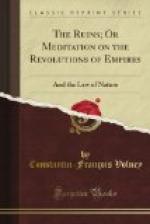And the Lama began to read:
“He that leaveth his father and mother to follow me,” says Fot, “becomes a perfect Samanean (a heavenly man).
“He that practices my precepts to the fourth degree of perfection, acquires the faculty of flying in the air, of moving heaven and earth, of prolonging or shortening his life (rising from the dead).
“The Samanean despises riches, and uses only what is strictly necessary; he mortifies his body, silences his passions, desires nothing, forms no attachments, meditates my doctrines without ceasing, endures injuries with patience, and bears no malice to his neighbor.
“Heaven and earth shall perish,” says Fot: “despise therefore your bodies, which are composed of the four perishable elements, and think only of your immortal soul.
“Listen not to the flesh: fear and sorrow spring from the passions: stifle the passions and you destroy fear and sorrow.
“Whoever dies without having embraced my religion,” says Fot, “returns among men, until he embraces it.”
The Lama was going on with his reading, when the Christians interrupted him, crying out that this was their own religion adulterated—that Fot was no other than Jesus himself disfigured, and that the Lamas were the Nestorians and the Manicheans disguised and bastardized.*
* This is asserted by our missionaries, and among others by Georgi in his unfinished work of the Thibetan alphabet: but if it can be proved that the Manicheans were but plagiarists, and the ignorant echo of a doctrine that existed fifteen hundred years before them, what becomes of the declarations of Georgi? See upon this subject, Beausob. Hist. du Manicheisme.
But the Lama, supported by the Chamans, Bonzes, Gonnis, Talapoins of Siam, of Ceylon, of Japan, and of China, proved to the Christians, even from their own authors, that the doctrine of the Samaneans was known through the East more than a thousand years before the Christian era; that their name was cited before the time of Alexander, and that Boutta, or Beddou, was known before Jesus.*
* The eastern writers in general agree in placing the birth of Beddou 1027 years before Jesus Christ, which makes him the contemporary of Zoroaster, with whom, in my opinion, they confound him. It is certain that his doctrine notoriously existed at that epoch; it is found entire in that of Orpheus, Pythagoras, and the Indian gymnosophists. But the gymnosophists are cited at the time of Alexander as an ancient sect already divided into Brachmans and Samaneans. See Bardesanes en Saint Jerome, Epitre a Jovien. Pythagoras lived in the ninth century before Jesus Christ; See chronology of the twelve ages; and Orpheus is of still greater antiquity. If, as is the case, the doctrine of Pythagoras and that of Orpheus are of Egyptian origin, that of Beddou goes back to the common source; and in reality the Egyptian priests recite, that Hermes as he




